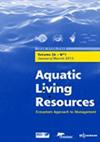含alvarezii Kappaphycus、螺旋藻和嗜碱盐单胞菌的合成菌提高了凡纳滨对虾(Litopenaeus vannamei)幼虫培养后的存活率、生长和抗弧菌性
IF 1.9
4区 农林科学
Q3 FISHERIES
引用次数: 0
摘要
机会致病菌弧菌造成的死亡率对虾类生产造成的巨大损失仍然是对虾业面临的重大挑战。合成饲料补充似乎是一种很有前途的控制策略,以保持健康的虾群。本研究研究了含合生益生元海藻阿尔瓦雷氏Kappaphycus alvarezii和螺旋藻sp.以及嗜碱盐单胞菌(Halomonas alkaliphila)对凡纳滨对虾幼虫后期的存活、生长和弧菌的影响。试验了5种不同的饲料:商品饲料、益生元alvarezii和螺旋藻补充饲料,以及alvarezii、螺旋藻和益生菌H. alkaliphila添加浓度分别为108、109和1010 CFU.kg−1的合成饲料。饲喂试验14 d后,在109 CFU时,添加0.375% alvarezii、0.125% Spirulina sp.和H. alkaliphila的合成饲料组的对虾存活率最高,为91.46±0.05%。Kg−1 (p <;0.05)。采用3个处理组对条件细菌哈维氏弧菌进行为期7天的攻毒试验:(1)含0.375%阿尔瓦雷氏弧菌、0.125%螺旋藻和嗜碱弧菌(109 CFU.kg−1)的合成菌;(2)益生元,含0.375% alvarezii, 0.125%螺旋藻;(3)控制,使用商业饲料。合成菌处理组对虾成活率最高,为(79.9±0.05%),其次为益生元处理组和对照组(p <;0.05)。结果表明,在109 CFU条件下,合成饲料中alvarezii、Spirulina sp.和H. alkaliphila的含量分别为0.375%、0.125%。kg−1显著提高了对虾的存活率,即使受到哈维氏弧菌的攻击。因此,这种合生菌可以作为一种潜在的替代生物防治策略,在集约化虾幼虫后养殖中防治弧菌病。本文章由计算机程序翻译,如有差异,请以英文原文为准。
Synbiotic containing Kappaphycus alvarezii, Spirulina sp. and Halomonas alkaliphila improves survival, growth and vibriosis resistance in whiteleg shrimp (Litopenaeus vannamei) post-larval culture
The high losses in shrimp production due to mortality caused by Vibrio opportunistic pathogens still constitute a significant challenge in the shrimp industry. Synbiotic feed supplementation appears to be a promising control strategy to maintain healthy shrimp stock. In this study, the effects of synbiotic-containing prebiotic seaweeds Kappaphycus alvarezii and Spirulina sp. as well as probiotic Halomonas alkaliphila were evaluated on the survival, growth, and vibriosis of Litopenaeus vannamei during the post-larval stage. Five different feeds were tested: commercial feed, prebiotics K. alvarezii and Spirulina sp.-supplemented feed, and synbiotic-supplemented feed using K. alvarezii, Spirulina sp. and probiotic H. alkaliphila with different concentrations of 108, 109, and 1010 CFU.kg−1. Following 14 days after the feeding test, the highest shrimp survival (91.46 ± 0.05%) was obtained in the treatment group fed with synbiotic-supplemented feed containing 0.375% K. alvarezii, 0.125% Spirulina sp., and H. alkaliphila at 109 CFU.kg−1 (p < 0.05). A 7-day challenge test against opportunistic bacteria Vibrio harveyii was then performed using three treatment groups: (1) synbiotic, containing 0.375% K. alvarezii, 0.125% Spirulina sp., and H. alkaliphila at 109 CFU.kg−1; (2) prebiotic, with 0.375% K. alvarezii, 0.125% Spirulina sp.; and (3) control, using commercial feed. The highest shrimp survival of (79.9 ± 0.05%) was found in the synbiotic treatment group, followed by the prebiotic and control treatment groups (p < 0.05). Overall results suggested that synbiotic-supplemented feed containing 0.375% K. alvarezii, 0.125% Spirulina sp., and H. alkaliphila at 109 CFU.kg−1 significantly improved shrimp survival even when challenged with V. harveyii. Thus, this synbiotic can be potentially applied as an alternative biocontrol strategy against vibriosis in intensive shrimp post-larval culture.
求助全文
通过发布文献求助,成功后即可免费获取论文全文。
去求助
来源期刊

Aquatic Living Resources
农林科学-海洋与淡水生物学
CiteScore
2.30
自引率
0.00%
发文量
10
审稿时长
>24 weeks
期刊介绍:
Aquatic Living Resources publishes original research papers, review articles and propective notes dealing with all exploited (i.e. fished or farmed) living resources in marine, brackish and freshwater environments.
Priority is given to ecosystem-based approaches to the study of fishery and aquaculture social-ecological systems, including biological, ecological, economic and social dimensions.
Research on the development of interdisciplinary methods and tools which can usefully support the design, implementation and evaluation of alternative management strategies for fisheries and/or aquaculture systems at different scales is particularly welcome by the journal. This includes the exploration of scenarios and strategies for the conservation of aquatic biodiversity and research relating to the development of integrated assessment approaches aimed at ensuring sustainable and high quality uses of aquatic living resources.
 求助内容:
求助内容: 应助结果提醒方式:
应助结果提醒方式:


